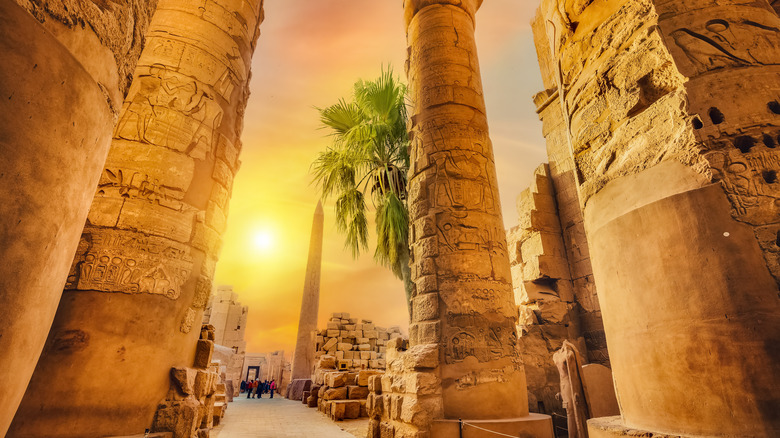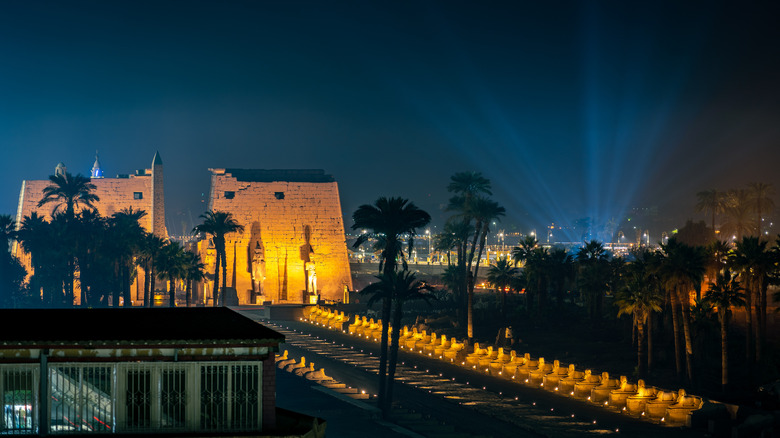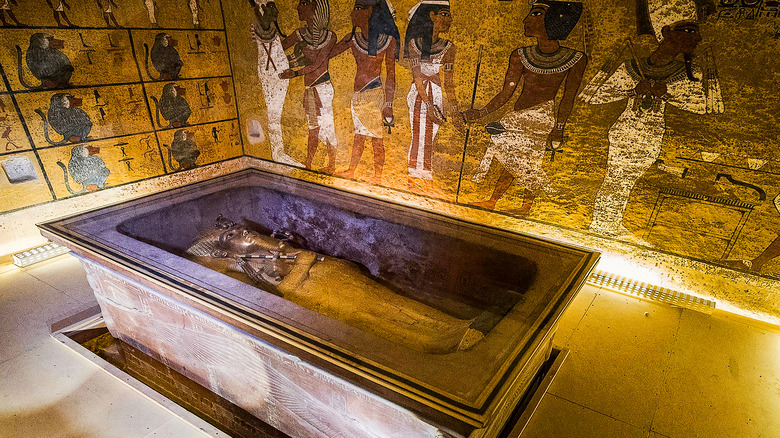Luxor Is An Essential Destination For Viewing Temples And Tombs In Egypt
Egypt is famous for being a cradle of an ancient civilization, and tourists worldwide flock to the country to see its numerous historic monuments. While Giza and its pyramids and the Sphinx are closer to Cairo, visitors who want to dig deeper into the country's ancient history tend to go further down south to Luxor. Located about 400 miles from the Egyptian capital lies what many have called "the world's greatest open-air museum," per Lonely Planet. A third of the ancient monuments of the world are said to have been preserved here, according to Egypt Today.
Luxor holds many temples, tombs, and other remnants of the time when it was the seat of Thebes, which was the capital of Egypt during the part of the Middle Kingdom and the New Kingdom (per National Geographic). If you visit the modern city today, you'll be able to have a glimpse at what the peak of Egyptian civilization might have looked like, according to UNESCO. The Nile River runs through the city, dividing it into the eastern bank, where the remains of great temples can be viewed, and the western bank, where an ancient necropolis lies.
Luxor's most sacred temples
On the eastern bank of the Nile are a duo of important religious structures: the Karnak Temple Complex and the Luxor Temple. Karnak was a major religious center during the New Kingdom era. Inside its massive complex measuring about one mile by half a mile were enormous structures, including obelisks, columns, and the statues of four gods, per National Geographic. The main structure is the temple of Amun and around it are two other huge temples dedicated to his wife, Mut, and son, Khonsu. In addition, Karnak also houses other smaller and outer temples built over 1,500 years, per the Egyptian Tourism Promotion Board.
The Karnak Temple Complex is connected to the Luxor Temple by the Avenue of Sphinxes, a 1.9-mile grand avenue that functioned as a processional road during the Opet Festival. During this festival, the ancient Egyptians brought the statues of Amun, Mut, and Khonsu from Karnak to the Luxor Temple, per Lonely Planet. The annual event celebrated the god Amun's rebirth in the Luxor Temple, per the World Monuments Fund.
Today, you'll still see the Great Colonnade Hall, towering columns, and statues of Ramses II. You'll also find an 82-foot-tall obelisk fronting the pylon and a shrine from the reign of Hatshepsut, per the Egyptian Ministry of Tourism and Antiquities. Lonely Planet suggests visiting early to avoid crowds, during sunset, or at night to see the temple light up. "We did this [at] night and the lighting made it extra special," wrote a TripAdvisor reviewer.
The royal tombs in Luxor's western bank
If the eastern bank of the Nile was the center of ancient Egyptian civilization, the western bank was the realm of the dead. Major burial sites for pharaohs and queens can be found here. The Valley of the Kings features more than 60 tombs, plus 20 unfinished ones, according to the Ministry of Tourism and Antiquities. The tombs range from single burial chambers to huge complexes with paintings and hieroglyphs, per the World Monuments Fund.
The most famous of these tombs is that of Tutankhamun, which made waves when it was discovered by Howard Carter in 1922 for the treasures it held inside, per National Geographic. "You can see the mummified body of King Tut preserved for all to see under a plexiglass box," a TripAdvisor reviewer noted. The tombs of Ramses II, Seti I, and other pharaohs can also be found here, per National Geographic.
Meanwhile, the Valley of the Queens contains around 90 tombs of New Kingdom queens, princes, princesses, and other nobles, per National Geographic. The most popular is the tomb of Ramses II's wife, Nefertari, per the Ministry of Tourism and Antiquities. "The best preserved, and I would say the most beautiful tomb that I saw was that of Queen Nefertari," a TripAdvisor reviewer wrote, adding, "The wall paintings look like they were painted yesterday. The colors are incredibly well preserved." Nearby is the ruin of an ancient village of tomb workers and artists, which is also worth a visit.


